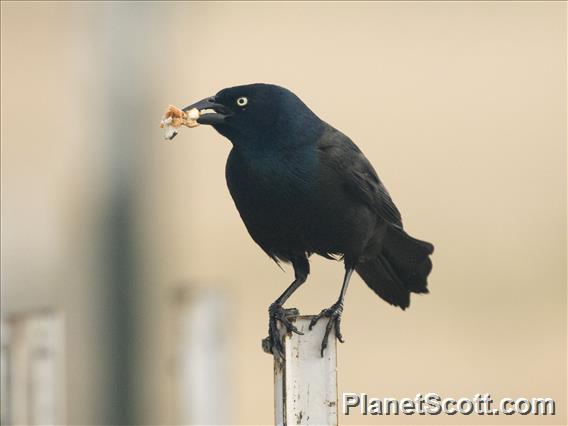Common Grackle (Quiscalus quiscula)

Common Grackle (Quiscalus quiscula)

Common Grackle (Quiscalus quiscula)


×



Common Grackle (Quiscalus quiscula)

Common Grackle (Quiscalus quiscula)
About Common Grackle (Quiscalus quiscula)
- Kingdom: Animals
- Phylum: Chordates
- Class: Birds
- Order: Perching Birds
- Family: American Blackbirds and Orioles
The common grackle is a species of large icterid bird found in large numbers through much of North America. First described in 1758 by Carl Linnaeus, the common grackle has three subspecies. Adult common grackles have a long and dark bill, pale yellow eyes, and a long tail. Adults often have a bluish iridescent appearance on their head, especially males. Common grackles can be found widely across North America east of the Rocky Mountains.
Source: Wikipedia
Visits
-
2007-06-14
Cape May Point State Park, United States of America -
-
2009-01-13
Western Kane County - Walker Road, United States of AmericaA very large flock of grackles and possibly other blackbirds on private property. -
2009-05-05
Elgin, United States of America -
2009-05-09
Nelson Lake Forest Preserve, United States of America -
2010-06-25
Elgin - Bluff Spring Fen, United States of America -
-
2012-07-09
Sax-Zim Bog, United States of America -
2012-07-10
170th St , United States of America -
2012-07-11
McKenzie Slough, United States of America -
2013-03-04
John Heinz NWR at Tinicum (IBA), United States of America -
2013-04-16
Aransas NWR (CTC 037) (Aransas Co.), United States of America -
2013-04-17
Brazoria NWR (UTC 108), United States of America -
2013-04-19
Bolivar Peninsula, United States of America -
-
-
-
-
-
-
-
2016-12-19
Fontainebleau State Park, United States of America -
-
-
-
-
-
-
-
-
-
-
-
-
-
-
-
-
-
-
-
-
-
-
-
-
-
-
2024-05-25
Keuka Lake, United States of America -
-






